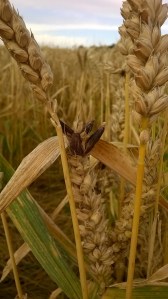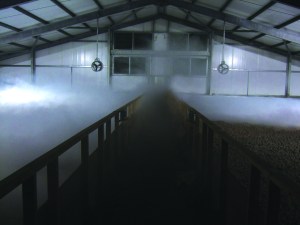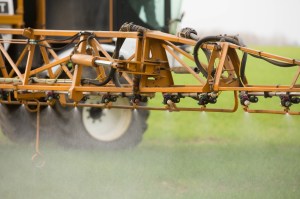Written by CPM Magazine from CPM Magazine
Download PDF
Monitoring contaminants is vital to ensure UK cereals and their by-products are safe and produced to a high standard. CPM looks at trends from a much-valued monitoring project and what it can tell us about the cereal supply chain.
By Adam Clarke
Worrying exceedances of key contaminants are rarely found in UK cereals before they’re sent for processing, which is a testament to the competence of growers who deliver wheat, barley, and oats for food and feed each year.
Although the bigger picture is positive, there are contaminants highlighted on the ‘watch list’, including ergot alkaloids and chlorpropham (CIPC) residues, and action is required to reduce the risk of any exceedances of limits for these in UK grain.
Since the mid-1980s the HGCA, which evolved into AHDB Cereals and Oilseeds, has been funding collaborative work with industry partners to determine levels of contaminants found in the main UK cereal crops.
As well as wheat, barley, and oats for human and animal consumption, testing extends to include by-products, such as wheat bran and oat hulls which are used in livestock rations.

Contaminants very rarely exceed the legal limits and it’s seasonal for some, such as mycotoxins caused by fusarium, says Dhan Bhandari.
Its current phase, which started in 2016 and is due to end in August 2023, has seen AHDB collaborating with UK Flour Millers, the Maltsters Association of Great Britain (MAGB), the British Oats and Barley Millers’ Association (BOBMA) and Agricultural Industries Confederation (AIC), which represents British feed mills.
AHDB’s Dhan Bhandari says that the long-term project is largely driven by the limited amount of testing that’s carried out on farm.
Growers monitor grain moisture and some quality characteristics, using the dipstick method to test grain for mycotoxins like DON and ZON. However, it’s grain processors that carry out more thorough testing for the presence of DON, ZON and their derivatives, T-2, and HT-2 toxins, and ochratoxin A, along with the presence of ergot sclerotia.
There are also masked versions of some mycotoxins that are only detectable once grain is ingested, so it requires specialist methodology to find them in raw materials ahead of entry into the food and feed chains.
Monitoring pesticide residues is also important for food safety standards, with the presence of more than 400 compounds being screened for, along with heavy metals like mercury, cadmium, arsenic, copper, and more recently, nickel, explains Dhan.
“Another is acrylamide, which can occur in cereals after the roasting process. All the testing for these substances is very expensive and a lot for individual companies to undertake alone,” he says.
This is where the project steps in, co-ordinating commercial intake samples that reflect what’s happening in fields or grain stores. In the past, testing has been carried out by Campden BRI, but Fera has taken on the contract through the most recent round of funding.
If exceedances of maximum limits (MLs) of mycotoxins, or maximum residue limits (MRLs) of substances like pesticides occur, Fera feeds back to the relevant body so industry is aware of an issue and can investigate, explains Dhan.
“When a sample is at its maximum level, it isn’t necessarily non-compliant as there’s some leeway which accounts for uncertainty of measurement around the result.
“However, if it’s confirmed as over the legal limit then the industry is in a good place to take action, stopping production if needs be, and investigate how a sample made it through the supply chain in the first place.”

Although ergot has been in the news lately due to elevated levels appearing in grain, it’s unlikely to cause ergotism and symptoms like hallucination.
Dhan adds that one of the main advantages of working collaboratively with the various independent bodies is the aggregation and sharing of data across industry, which is discussed at an annual meeting of stakeholders and published online.
“Generally, we find that contaminants very rarely exceed the legal limits and it’s seasonal for some, like mycotoxins caused by fusarium. In the past couple of years, ergot has been in the news, with elevated levels appearing in grain. This project has been instrumental in picking that up, with samples tested for 12 ergot alkaloids by a specialist lab, like Fera,” explains Dhan.
It’s one of only two accredited labs able to test for ergot alkaloids. Undertaking the process requires the facility to hold a Home Office license, permitting it to hold reference alkaloids that could be used in the synthesis of class A drug, LSD.
Leading the project’s testing efforts at Fera is Susan McDonald, with various teams at its York facility looking for mycotoxins, pesticide, and heavy metal residues in some 400 grain or grain by-product samples each year.
Susan says there are rarely notable issues with well-known mycotoxins like DON and ZON and last year, the substances were at among the lowest level ever seen in testing due to the hot and dry weather. This is the converse to some of the 12 ergot alkaloids, which have been high in recent seasons.
After Brexit, the EU introduced a regulation that lists the 12 ergot alkaloids and sets a ML based on the sum of all alkaloids found in each sample analysed. Fera follows the same protocol and the chemical test for them requires the sample to be milled much finer than for other substances, because if fragments of ergot sclerotia are not ground down and evenly distributed through the sample, results can be skewed, she explains.
Samples are then analysed by liquid chromatography-mass spectrometry (LC-MS), which separates compounds using organic solvents, then mass spectrometry is used to measure compounds based on molecular mass.
“When we started testing for alkaloids, we had high levels in the first year, then they seemed to drop again. However, in the past two years they’re right back up, particularly in milling wheat,” says Susan.
She adds that it’s not a huge concern, with the elevated levels extremely unlikely to cause ergotism, where consumers of tainted products can hallucinate.
“But it does show the importance of the monitoring process and that industry is doing all it can to make sure UK grain quality is good,” she adds.
Dhan says there are a few reasons behind the high alkaloid levels, one of which is the increasing trend towards establishing mixed species margins around cereal fields. Ergot can infect grasses within these margins and act as a source of inoculum for surrounding crops at flowering, when they are most susceptible to infection, he explains.
Similarly, the proliferation of grassweeds within crop rotations is also providing a willing host for ergot, which helps the fungus to continue its lifecycle in cereals. Rather than being buried with a plough, reduced tillage or direct drilling is leaving sclerotia exposed on the soil surface, posing a greater risk to following crops.
“After sclerotia are produced in the ear of wheat, barley, or rye, and fall to the ground in the autumn, it’s temperature and moisture the following spring that will influence germination and release of spores that infect surrounding crops, so climate change could also be a factor,” suggests Dhan.
With policy taking farming down the path of more field margins and less tillage, improving risk assessments and adapting management is an immediate priority, he believes.

A compound being detected annually during contaminant testing is the now-withdrawn potato sprout suppressant, CIPC.
Dhan suggests one means of reducing risk could be mowing field margins before the grasses come into flower, reducing the amount of sclerotia returning to the soil as a source of inoculum. Using clean, certified seed also minimises risk, and where using home-saved seed it should be cleaned.
Later, at harvest, there’s potential to cut out risky areas first, reducing overall contamination in the bulk of the crop. “It should be noted that cleaning is only effective to a point but if you overdo it, then sclerotia can be broken into much smaller fragments and are impossible to separate from grain,” explains Dhan.
He adds that diagnostics companies are developing a rapid test for ergot alkaloids, which could help growers identify problem grain stocks, but these are some way from commercial launch.
“AHDB has a useful factsheet on the management of ergot, which is a good resource,” says Dhan.
Away from mycotoxins, the project also closely monitors pesticide residues and although compounds are regularly found, they are generally below the MRL. Susan believes this underlines the good practice in the UK when using plant protection products.

Monitoring pesticide residues is important for food safety standards, with more than 400 compounds being tested for.
Put into context, throughout the duration of the current project, several thousand samples have been processed to look for residue of up to 400 pesticides, and just half a dozen have exceeded legal limits.
However, one notable compound that has been showing up is potato sprout suppressant chlorpropham (CIPC). Prior to its withdrawal in 2019, potato stores were routinely fogged with CIPC which impregnated the fabric of buildings, particularly concrete, and is almost impossible to remove.
“Studies have shown cleaning to only be partially effective because the chemical persists for many years,” says Dhan.
As the sprout suppressant is banned, its MRL is now limit of detection (LOD), so the advice is that if a store has ever been used to store potatoes, don’t put grain in it.
“Where that’s unavoidable, sampling and testing grain that might be at risk of contamination can help identify problems that could end up in rejected grains,” he concludes.
This article was taken from the latest issue of CPM. Read the article in full here.
For more articles like this, subscribe here.
Sign up for Crop Production Magazine’s FREE e-newsletter here.
The post An eye on visible and subtle threats appeared first on cpm magazine.
Continue reading on CPM website...
If you are enjoying what you read then why not considering subscribing here: http://www.cpm-magazine.co.uk/subscribe/
Download PDF
Monitoring contaminants is vital to ensure UK cereals and their by-products are safe and produced to a high standard. CPM looks at trends from a much-valued monitoring project and what it can tell us about the cereal supply chain.
By Adam Clarke
Worrying exceedances of key contaminants are rarely found in UK cereals before they’re sent for processing, which is a testament to the competence of growers who deliver wheat, barley, and oats for food and feed each year.
Although the bigger picture is positive, there are contaminants highlighted on the ‘watch list’, including ergot alkaloids and chlorpropham (CIPC) residues, and action is required to reduce the risk of any exceedances of limits for these in UK grain.
Since the mid-1980s the HGCA, which evolved into AHDB Cereals and Oilseeds, has been funding collaborative work with industry partners to determine levels of contaminants found in the main UK cereal crops.
As well as wheat, barley, and oats for human and animal consumption, testing extends to include by-products, such as wheat bran and oat hulls which are used in livestock rations.

Contaminants very rarely exceed the legal limits and it’s seasonal for some, such as mycotoxins caused by fusarium, says Dhan Bhandari.
Its current phase, which started in 2016 and is due to end in August 2023, has seen AHDB collaborating with UK Flour Millers, the Maltsters Association of Great Britain (MAGB), the British Oats and Barley Millers’ Association (BOBMA) and Agricultural Industries Confederation (AIC), which represents British feed mills.
AHDB’s Dhan Bhandari says that the long-term project is largely driven by the limited amount of testing that’s carried out on farm.
Growers monitor grain moisture and some quality characteristics, using the dipstick method to test grain for mycotoxins like DON and ZON. However, it’s grain processors that carry out more thorough testing for the presence of DON, ZON and their derivatives, T-2, and HT-2 toxins, and ochratoxin A, along with the presence of ergot sclerotia.
There are also masked versions of some mycotoxins that are only detectable once grain is ingested, so it requires specialist methodology to find them in raw materials ahead of entry into the food and feed chains.
Monitoring pesticide residues is also important for food safety standards, with the presence of more than 400 compounds being screened for, along with heavy metals like mercury, cadmium, arsenic, copper, and more recently, nickel, explains Dhan.
“Another is acrylamide, which can occur in cereals after the roasting process. All the testing for these substances is very expensive and a lot for individual companies to undertake alone,” he says.
This is where the project steps in, co-ordinating commercial intake samples that reflect what’s happening in fields or grain stores. In the past, testing has been carried out by Campden BRI, but Fera has taken on the contract through the most recent round of funding.
If exceedances of maximum limits (MLs) of mycotoxins, or maximum residue limits (MRLs) of substances like pesticides occur, Fera feeds back to the relevant body so industry is aware of an issue and can investigate, explains Dhan.
“When a sample is at its maximum level, it isn’t necessarily non-compliant as there’s some leeway which accounts for uncertainty of measurement around the result.
“However, if it’s confirmed as over the legal limit then the industry is in a good place to take action, stopping production if needs be, and investigate how a sample made it through the supply chain in the first place.”

Although ergot has been in the news lately due to elevated levels appearing in grain, it’s unlikely to cause ergotism and symptoms like hallucination.
Dhan adds that one of the main advantages of working collaboratively with the various independent bodies is the aggregation and sharing of data across industry, which is discussed at an annual meeting of stakeholders and published online.
“Generally, we find that contaminants very rarely exceed the legal limits and it’s seasonal for some, like mycotoxins caused by fusarium. In the past couple of years, ergot has been in the news, with elevated levels appearing in grain. This project has been instrumental in picking that up, with samples tested for 12 ergot alkaloids by a specialist lab, like Fera,” explains Dhan.
It’s one of only two accredited labs able to test for ergot alkaloids. Undertaking the process requires the facility to hold a Home Office license, permitting it to hold reference alkaloids that could be used in the synthesis of class A drug, LSD.
Leading the project’s testing efforts at Fera is Susan McDonald, with various teams at its York facility looking for mycotoxins, pesticide, and heavy metal residues in some 400 grain or grain by-product samples each year.
Susan says there are rarely notable issues with well-known mycotoxins like DON and ZON and last year, the substances were at among the lowest level ever seen in testing due to the hot and dry weather. This is the converse to some of the 12 ergot alkaloids, which have been high in recent seasons.
After Brexit, the EU introduced a regulation that lists the 12 ergot alkaloids and sets a ML based on the sum of all alkaloids found in each sample analysed. Fera follows the same protocol and the chemical test for them requires the sample to be milled much finer than for other substances, because if fragments of ergot sclerotia are not ground down and evenly distributed through the sample, results can be skewed, she explains.
Samples are then analysed by liquid chromatography-mass spectrometry (LC-MS), which separates compounds using organic solvents, then mass spectrometry is used to measure compounds based on molecular mass.
“When we started testing for alkaloids, we had high levels in the first year, then they seemed to drop again. However, in the past two years they’re right back up, particularly in milling wheat,” says Susan.
She adds that it’s not a huge concern, with the elevated levels extremely unlikely to cause ergotism, where consumers of tainted products can hallucinate.
“But it does show the importance of the monitoring process and that industry is doing all it can to make sure UK grain quality is good,” she adds.
Dhan says there are a few reasons behind the high alkaloid levels, one of which is the increasing trend towards establishing mixed species margins around cereal fields. Ergot can infect grasses within these margins and act as a source of inoculum for surrounding crops at flowering, when they are most susceptible to infection, he explains.
Similarly, the proliferation of grassweeds within crop rotations is also providing a willing host for ergot, which helps the fungus to continue its lifecycle in cereals. Rather than being buried with a plough, reduced tillage or direct drilling is leaving sclerotia exposed on the soil surface, posing a greater risk to following crops.
“After sclerotia are produced in the ear of wheat, barley, or rye, and fall to the ground in the autumn, it’s temperature and moisture the following spring that will influence germination and release of spores that infect surrounding crops, so climate change could also be a factor,” suggests Dhan.
With policy taking farming down the path of more field margins and less tillage, improving risk assessments and adapting management is an immediate priority, he believes.

A compound being detected annually during contaminant testing is the now-withdrawn potato sprout suppressant, CIPC.
Dhan suggests one means of reducing risk could be mowing field margins before the grasses come into flower, reducing the amount of sclerotia returning to the soil as a source of inoculum. Using clean, certified seed also minimises risk, and where using home-saved seed it should be cleaned.
Later, at harvest, there’s potential to cut out risky areas first, reducing overall contamination in the bulk of the crop. “It should be noted that cleaning is only effective to a point but if you overdo it, then sclerotia can be broken into much smaller fragments and are impossible to separate from grain,” explains Dhan.
He adds that diagnostics companies are developing a rapid test for ergot alkaloids, which could help growers identify problem grain stocks, but these are some way from commercial launch.
“AHDB has a useful factsheet on the management of ergot, which is a good resource,” says Dhan.
Away from mycotoxins, the project also closely monitors pesticide residues and although compounds are regularly found, they are generally below the MRL. Susan believes this underlines the good practice in the UK when using plant protection products.

Monitoring pesticide residues is important for food safety standards, with more than 400 compounds being tested for.
Put into context, throughout the duration of the current project, several thousand samples have been processed to look for residue of up to 400 pesticides, and just half a dozen have exceeded legal limits.
However, one notable compound that has been showing up is potato sprout suppressant chlorpropham (CIPC). Prior to its withdrawal in 2019, potato stores were routinely fogged with CIPC which impregnated the fabric of buildings, particularly concrete, and is almost impossible to remove.
“Studies have shown cleaning to only be partially effective because the chemical persists for many years,” says Dhan.
As the sprout suppressant is banned, its MRL is now limit of detection (LOD), so the advice is that if a store has ever been used to store potatoes, don’t put grain in it.
“Where that’s unavoidable, sampling and testing grain that might be at risk of contamination can help identify problems that could end up in rejected grains,” he concludes.
This article was taken from the latest issue of CPM. Read the article in full here.
For more articles like this, subscribe here.
Sign up for Crop Production Magazine’s FREE e-newsletter here.
The post An eye on visible and subtle threats appeared first on cpm magazine.
Continue reading on CPM website...
If you are enjoying what you read then why not considering subscribing here: http://www.cpm-magazine.co.uk/subscribe/





